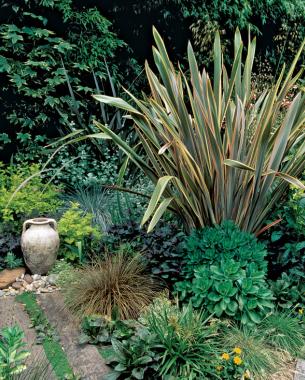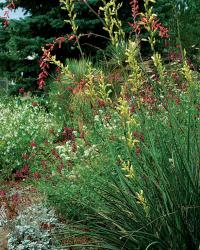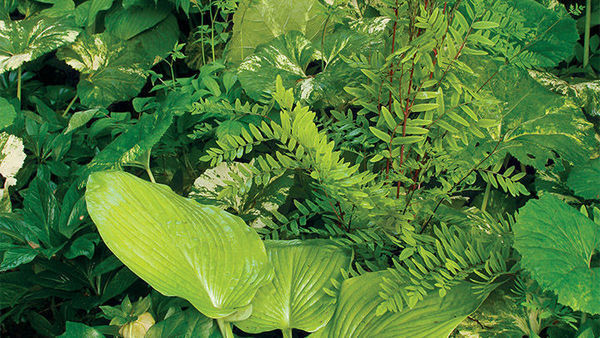
I’m addicted to spikes, spears, and swords. I’m not talking about medieval weapons; I’m talking about edgy, architectural plant forms that invigorate gardens with excitement. Give me a planting to design, from urban verandas to country courtyards, and I just can’t resist including a mix of spiky plants like yuccas, agaves, or prickly pear cacti. These plants always deliver, adding striking, structured form with their narrow leaves, pointy spines, and toothed edges.
Although many gardeners consider spiky plants strictly Southwest or desert inhabitants, these brash beauties are bucking their tender or difficult reputations by proving to be strong seasonal performers from Philadelphia, Pennsylvania, to Portland, Oregon. Given the right soil, drainage, and sun exposure, many spiky plants are hardier and more adaptable than gardeners may think.

Because spiky plants come in a vast array of forms, textures, and sizes, they can be used to add drama just about anywhere. The most successful designs feature small spiky plants in masses or groups and showcase large specimens as focal points, while pairing them all with companions that have complementary forms and similar cultural needs.
When designing with spiky plants, especially rosettes (plants with clustered leaves arranged like a rose blossom), recite this mantra: “Repetition, repetition, repetition.” These plants can look out of place without some spiky cohorts; by planting together several of one variety or similar-looking species, you can make the whole creation look purposeful, connected, and a bit more natural. Plants can be repeated in a mass planting or in multiple, smaller groupings throughout an area or garden. This approach is particularly effective when using small plants like flat sea hollies (Eryngium planum and cvs., USDA Hardiness Zones 5–9) and dollhouse yucca (Yucca harrimaniae, Zones 5–9).
Repeat smaller spikes, but let larger ones stand alone


To create lines of sight and to direct visitors through the garden, use larger specimens, such as New Zealand flax and sotol, in fewer numbers or as individual focal points. I like to do this by placing large, bold plants at the end of a path. I also stage sizable plants at corners to interrupt or decrease the distance between sight lines, which keeps the garden from being predictable and provides surprises with each turn. In small spaces, such as patios and balconies, large specimens make the perfect corner focal points. Their modern, clean look enhances the view and makes a small area seem bigger and more intriguing—just as an oversize piece of furniture does in a little room.
Fine-textured plants make great bedfellows

Whether you are using spiky plants in groups or displaying them as focal points, pay attention to their neighbors. Try to avoid dueling bold forms and textures that compete for attention, like a prickly pear cactus or agave next to your favorite peony (Paeonia spp. and cvs., Zones 3–8). Instead, start simply and create drama by combining spiky plants with soft, contrasting fine textures and loose forms, like those of ornamental grasses or artemisias (Artemisia spp. and cvs., Zones 3–9). Another trick is to establish harmony by choosing companions with similar characteristics, like bluish gray color, smooth-cut leaves, or starburst form.
Perhaps the easiest way to design with spiky plants is to use them as the overall theme for a bed or garden room. They provide an exotic look, which can be rounded out and highlighted with the unobtrusive forms of small grasses and clumping plants, such as sedums (Sedum spp. and cvs., Zones 3–9) or buck wheat (Eriogonum spp. and cvs., Zones 3–11), and shrubs, such as dwarf conifers, Apache plume (Fallugia paradoxa, Zones 5–10), or Japanese holly (Ilex crenata and cvs., Zones 5–8).
Plants that get to the point


Prickly pear cacti
(Opuntia spp. and cvs.)
Zones: 4–11
No discussion about spiky plants would be complete without prickly pear cacti. As with yuccas and agaves, the choices from this genus are nearly endless. Often displaying spiny pads that resemble a beaver’s tail, these plants stand from 6 inches to 48 inches tall.
Agaves
(Agave spp. and cvs.)
Zones: 6–11
Agaves are the poster children of the spiky plant world. While a surprising number survive in cold climates, you can grow less-frost-hardy species in containers and move them inside when the cold is too severe. Agaves often sport steel blue foliage and range anywhere from 1 foot to 12 feet tall.


New Zealand flaxes
(Phormium spp. and cvs.)
Zones: 8–11
The colorful, linear leaves of New Zealand flaxes are sure to leave an impression on any gardener. Plants shoot up 2 feet to 12 feet tall as they display their bronze, green, and sometimes cream-variegated foliage.
Sea hollies
(Eryngium spp. and cvs.)
Zones: 3–11
For something a little different, look to sea hollies to add some zip. Not only do they come in a vast array of forms and textures, but they also don’t mind soggy ground. Plants can grow from 6 inches to 48 inches tall and exude the most spikiness when in bloom.



Sotols
(Dasylirion spp.)
Zones: 8–11
Sotols reach from 3 feet to 8 feet tall. Smaller plants are great grown in masses, while larger plants create an incredible ambience as specimens. The narrow leaves of these plants look striking when waving in the breeze and backlit.
Hesperaloes
(Hesperaloe spp. and cvs.)
Zones: 6–11
Closely related to agaves, hesperaloes sport narrow, almost grasslike leaves. Growing 1½ feet to 5 feet tall, these plants are suitable for beds and containers. They attract hummingbirds in summer with their coral-hued and yellow flowers.
Yuccas
(Yucca spp. and cvs.)
Zones: 4–11
Yucca is a big genus with many fabulous plants to choose from. Its starburst forms range from 12-inch-tall spheres to 10-foot-tall trunked specimens. While their lance-shaped leaves usually have a touch of blue-gray, some varieties offer variegated foliage.
Pay attention to conditions when siting your spikes

Attention to growing needs is, of course, an important part of gardening with spiky plants. Though most species prefer full sun or a bit of afternoon shade in the hottest climates, a surprising number of spiky plants will tolerate partial shade. Many species are native to drier habitats and have adapted their shapes to conserve water. They do appreciate, however, occasional water in summer. Although some spiky plants will handle damp soil, a good rule of thumb is to provide all spikes with sharp drainage (soil that does not retain much moisture and drains quickly). I amend planting beds with pumice, perlite, gravel, or sand. This helps with drainage in all but heavy soils (in the latter, these ingredients end up resembling an adobe brick).
If you do garden in heavy soil, consider growing spiky plants in containers, where you have more control over the soil conditions. Because containers are portable, they also allow you to experiment with your planting schemes. Be aware, however, that plants in containers don’t grow as large because root space is limited. More attention to water needs is also required, and if you are concerned about hardiness, remember to subtract a zone from the plant’s expected frost hardiness. Plants in containers are, of course, more susceptible to cold temperatures.
Finicky tender plants can be stored in a protected location to sustain them through the winter. Bring potted plants indoors from the cold and place them in a greenhouse, basement, or sunroom, or even on the living-room floor. Plants enjoying indoor warmth benefit from bright light and are best kept on the dry side to minimize any new growth. Once the threat of frosty temperatures has ceased in spring, plants can be moved back outdoors. Make the transition gradual, placing your babies in the shade for a while, slowly exposing them to a full-sun position.
In areas where plants are borderline hardy and left in the ground, you may need to provide temporary protection from time to time. For heavy winter precipitation, a common danger, consider a water-shedding cover such as a simple, clear umbrella or a Plexiglas roof—a method often used in rock gardens—for smaller specimens. When temperatures briefly hover on the cold side, use old blankets, towels, sheets, or even burlap as temporary covers.
For the best results with your spiky plants, learn as much as possible about your choices, especially their tolerances for cold, drought, light, and soil types. Don’t be afraid to push the envelope. Fearless gardeners are learning that these plants can grow in and add excitement to the garden in the least expected places.

















Comments
Spiky plants just like big leaved plants are essential to create interest in a garden. While I agree that Eryngiums (sea hollies) are lovely, I do question the notation that they will do well in soggy soil. Perhaps that is true in seaside climates like Florida. However, in Atlanta, they thrive only in my driest, sharply drained areas. Wet feet will kill them fast.
Would there be any interest in the spikes of these Australian grass trees?
Log in or create an account to post a comment.
Sign up Log in